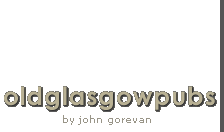H.L.I.
757 Maryhill Road, Glasgow.
The H.L.I. Bar stood at the corner of Maryhill Road and Kelvinside Avenue. This old pub was formerly known as the Kelvinside Bar.
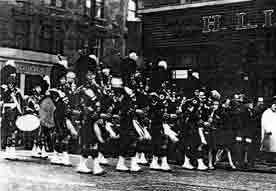
The pipers of the H.L.I. march proudly along Maryhill Road. After the parade they would march back up Maryhill Road to the barracks. 1970s.
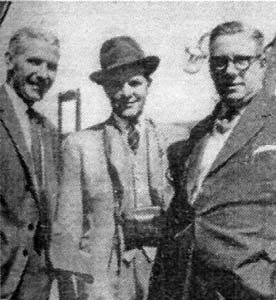
This photograph was taken in the summer of 1959, on a cruise doon that water with the Scottish Benevolent. Left to right J Sime, Clachan Bar, Paisley Road West; N Andrew, H.L.I.; J T Wharry, Director of Campbell and Clark Ltd.
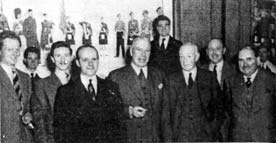
This photograph was taken at the refurbishment of the H.L.I. Bar in 1957. Left to right Captain A G Ingram, adjutant, H.L.I.; Mr D Anderson, artist; N Andrew, licence-holder; Colonel Robert Younger, chairman, Robert Younger Ltd.; J B Millar, managing director, Robert Younger's: Major B S M Carson, Commander, Maryhill Depot, H.L.I.; and D Ross, Director, Robert Younger's. In the background is J Webster, Change-Hand.
One of the brightest and most attractive pieces of re-decoration seen for a long time had been completed at the H.L.I. Bar in Maryhill Road, Glasgow.
The name in view of events, had been happily chosen, but it was selected long in advance of the present publicity for the affair of the H.L.I.
The idea, in fact, came from a customer. He suggested the Happy Lad's Inn, using the initials of the H.L.I. It was decided to use the letters and not the words, but the customer got the prize of a bottle of whisky for all that. So now with the prospect of an H.L.I./R.S.F. merger, the public house will acquire something of an historic interest.
In a measure it had that already, of course, for the theme of its decoration is entirely H.L.I. and official blessing, as it were, was given to the project by the presence as a guest at the opening of Major B S M Carson, commander of the H.L.I. Depot at Maryhill Barracks.
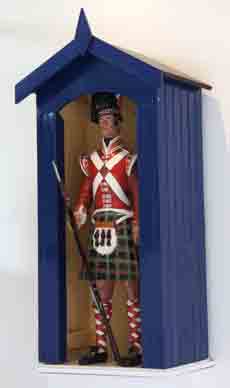
The sentry in his sentry box is now displayed at the re-opened Maryhill Burgh Halls… Thanks to Gordon Barr, Heritage Devolopment Officer.
Above the long gantry was a most handsome mural painting of men of the H.L.I. in the regiment's various uniforms. The artist, Mr Douglas Anderson, had specialised in military painting, and he at one time was adjutant of the H.L.I.'s 1st Battalion. He was still associated with that regiment as honorary curator of the H.L.I.'s regimental museum.
For the walls he had painted a series of studies of the regiment's headdress from 1777 onwards. And to adorn the pubs facade he had carved and painted a striking effigy in wood of an H.L.I. braw laddie.
Mr Anderson's mural had been given a coating of a special preparation which, when it dirties, may be removed and re-applied again without harming the painting or affecting its colouring in any way.
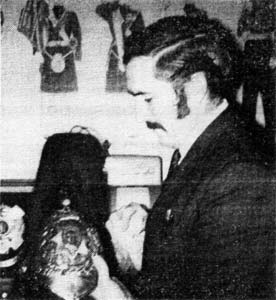
Manager John Johnstone with some of the items of the Military collection in the H.L.I. Bar. 1970.
The collection of the H.L.I. Bar in Maryhill Road, Glasgow, really starts outside the premises, at the small-scale sentry box complete with Highland Light Infantry soldier on guard.
Then in the entrance-way there was a stained glass window containing the H.L.I. badge, one of the many such representations in the bar.
Inside were other regimental items, the main ones being a mural of the H.L.I. dress throughout its history and six paintings of regimental headgear ranging from 1777 to 1957.
All the art work was done by local artist Douglas Anderson a former H.L.I. officer, he was called on by the former owners in 1957 (Scottish & Newcastle Breweries took over the licence three years later) to do the decor and decided on the theme of the regiment's dress in the mural and its headgear in the six portraits.
The mural was a great conversation point with customers and visitors of the bar, some of whom, especially in the late evenings, dispute technical points about the work.
There was one regular who posts himself opposite the mural, points to the big soldier on the left-hand side of the painting and declares to those around: "See that fella? Ah sodgered wi' him."
Unfortunately for that old sweat I have the artist's word for it that there is no such person. "Although I was stationed with the regiment at that time there were no models used for the model," stated Douglas.
Artist Douglas also did the sentry box model which H.L.I. Bar manager John Johnstone decorated with fairy lights during the Christmas celebrations. "The lit-up landmark proved so popular in the district that we've kept it that way ever since," said John.
Other decorations inside the bar included an alcove pelmet done in bonnet dicing; some plumed dress helmets and four breastplates (one marked "Klingenthal Juin 1828") which were fine for effect but didn'y appear to have any real link with the regiment; a couple of carved H.L.I. plaques; and a belt buckle of the Royal Highland Fusiliers, the regiment created out of the merging of the Highland Light Infantry and the Royal Scots Fusiliers.
John became manager, with his wife Nancy as assistant, at the H.L.I. Bar in 1968 after 15 years in the Merchant Navy, but he does have a strong link with the regiment in that his father was a bandsman in the H.L.I. and was a life member of the regimental club.
The bar being within rifleshot of Maryhill Barracks many of its customers were local men who served in their regiment, and there were also serving soldiers and ex-soldiers who make sentimental journeys back because of their Service days in the district.
"For this reason I'd really like to get some unit photographs," said John, who felt this would give ex-H.L.I. members a chance to identify even more with their regimental "headquarters."
End.
